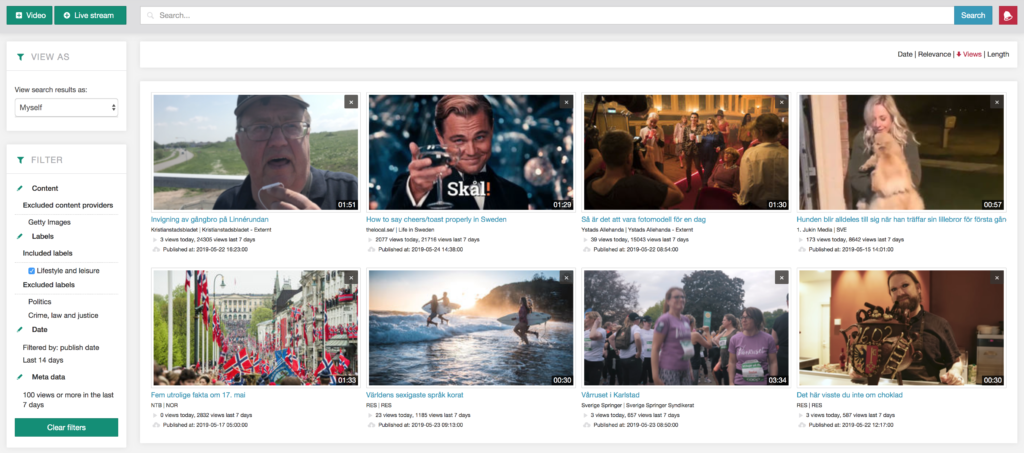Advanced & Saved Searches
Finding the right content can be a time consuming task. Curating the right content even more so, especially when you want to keep it updated and relevant. When you have a large video archive, and when you are pulling in syndicated content across hundreds of providers, this can easily become a multi-person full time job.
This is why we are now introducing two new core features, Advanced Search and Saved Search. The advanced search allows for much more granular and context aware searching, enabling you to include or exclude providers, labels, date ranges, view counts and a number of other parameters which we will detail further down in the post.
These searches can then be saved, either for personal use such as to easily find content again at a later date, or they can be saved for publishing use such as in a playlist. What this then enables is for you to create a broad or granular search to get exactly the content you want, and then to always get the latest matching content every time you view the saved search either via the admin, playlist, or feed.

How to search…
On your main dashboard view, you will now notice a new button “Advanced Search” which will take you to a new page with a lot more options to search with. You still have the standard search bar at the top which will perform a text search on the titles, descriptions, and freeform tags against media you have access to. With no search term added, you will see all available content.
On the left hand side, there is the “view as” functionality, this is because as a user you might be granted access to additional content via permissions but if you want to check what content a specific publisher of yours will have access to via syndication, you can select your publisher here and the search results will be updated accordingly.
Lastly there is the filter box, this will narrow down your available content by a number of different options.
Content filtering
Drill down across all of the content sources you have access to, down to the program level. At any level of the content hierarchy you can include specific parts of the content tree, only selected content will appear in your results. Alternatively you can select to exclude this content if you wish to filter out content instead of include it in your results. You can move the slider back to the central position to neither explicitly include or exclude it in your results.
Label filtering
Labels are a break away from our freeform tagging, whilst freeform tags allow you to give arbitrary tags that can be searched via the text search, this leads to difficulty when finding appropriate content from other providers, as you may not know how they tag their content. With labels, we provide a structured way to attach read-only labels to content, these labels are then predictable and can easily be used for advanced searching. In the same way as content, labels can be either included, or excluded from search results allowing for expressions such as “Include all sports content, but exclude football”.
Note: When you have content or labels selected in your filter, you will notice that on the box at the left there are now check boxes next to each item which are checked by default. These check boxes signify that the item MUST be present to be included in the result, if they are unchecked then the result must match one of the items, but does not need to match all of them. This way you could perform searches that express “Show content only with football AND news labels” or “Show content either football OR news labels”.
Date filtering
To limit your results further, you can select date ranges to include content from. These can either be provided as absolute date ranges or as a relative date, such as the past 7 days if you wish to have a search result showing recent media.
Metadata filtering
Here are a number of options to help curate media that’s important to you, you can limit by the length of media, what type of media it is (video or live stream), how many views it should have before it’s included, and whether or not you want to include your unpublished media.
Additional options
There are a number of other options to search with, however these are not as visible as the features we have described above as we are still working on the user experience for the new advanced search. For example, on specific parts in your search results, there is a “x” in the top right corner, which when clicked will remove that specific media from your search results, however this is not yet shown clearly that it has been removed. You can also prefix the search text with a “+” sign to include a word or “-” to exclude it, for example “Stockholm -football” to find media about Stockholm but that doesn’t include the word football anywhere in the text.
We’re also interested in hearing feedback and suggestions for the advanced search, if you have any feedback, please contact us at support@youplay.se and we’d be glad to listen!
Saved searches & Playlists
When you have created a search that represents the type of content you want, you can then save this search. You can either save it for yourself, which is useful if you want to check on this search later to see what new results there are, or you can save this search for a Publisher under your account, which means that anyone with sufficient permissions for that Publisher can update the saved search at a later date.
You can mark saved searches as public, which then allows them to be used for public facing features such as playlists and feeds. This distinction is important as public saved searches then have the possibility of affecting content on your sites if they are in use for playlists or feeds and should be edited with more care.
Once you have saved your search, you can always come back later and update the search parameters if your needs change at a later time.
Embedding your search results
Once you have saved your search, and if you have made it public – you can then create a playlist or feed using it. This then becomes very powerful as you can embed the playlist on your site, and it will always be up to date with the latest matches from your search result, allowing an incredibly flexible and dynamic playlist.

Simply select “Saved search” under the “Add new items to playlist” option, and your playlist will be ready to be embedded in a customised player of your choice. Once you embed the player, you will not need to update anything, however if you wish to change the search parameters, you can update the saved search and the results will automatically take effect.
Example usage
When introducing a new, relatively complex feature, it can sometimes be a bit difficult to understand how or why it should be used. We’ve collected a few examples below to give you ideas.
Latest Sports Content – A simple search to find all the latest sports content, sorted by date.
- Open up the Labels filter, find “Sport” in the Media Topics category. Move the slider to the right to include it.
- Click the “Filter” button and close the dialogue.
- Ensure that the sorting in the top right is set to “Date” with the arrow pointing downwards.
- Save your search and attach it to a playlist!
Recent Popular Cinema, TV & Fashion – Find the latest popular content matching one of these three categories.
- Open up the Labels filter, find “Arts, Culture, Entertainment” under the Media Topics category. Move the slider to the right to include it.
- In the expanded “Arts, Culture, Entertainment” category, select these three labels “Cinema”, “TV”, “Fashion”.
- Click the “Filter” button and close the dialogue.
- In the “Filter” box on the right, uncheck these three items, leaving “Arts, Culture, Entertainment” checked.
- Click on “Date” and enter 7 in the relative days filter to get the last 7 days of media.
- Ensure that the sorting in the top right is set to “Views” with the arrow pointing downwards.
- Save your search and attach it to a playlist!
Note: Unselecting the “Cinema”, “TV”, and “Fashion” labels from the main view means that the media only needs to match one of the labels, if you leave them selected they will have to match all of the labels which significantly narrows down the matching content.

